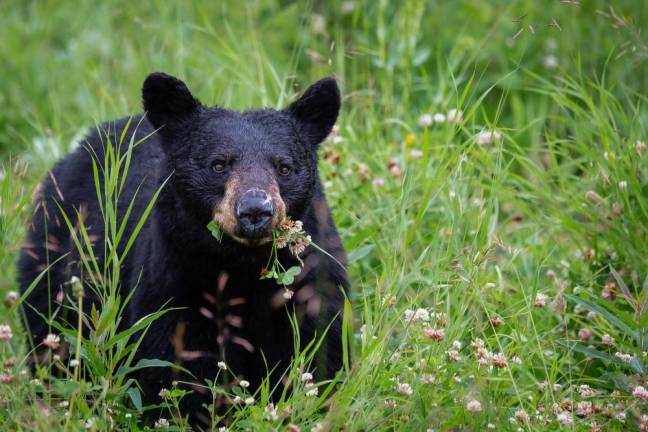What bears do in August

August at a glance: Bears have many ways to stay cool during hot summer days. By August, most cubs are weaned. Cubs can often survive on their own if they have to. Bears feast on ripening berries and may travel great distances to dependable food sources. Bears decipher complex messages left in the scents of other bears.
How bears beat the heat
Bears don’t have sweat glands and can’t take off their fur coats, so they can’t cool off the way people do when temperatures soar. However, bears do lose much of the dense underfur that helps keep them warm when temperatures drop. Shedding some of that fur lets air circulate while still “shading” their skin from the sun. They also pant like dogs and dissipate heat through their paws and other areas with little hair.
Bears avoid the hottest parts of the day and often relax in daybeds under a nice shady tree. They will also spread out on their lightly furred bellies and take a cool mud bath or chill out in a wetland. Bears will sometimes seek shelter from the sun on a cool, shady stone patio, under decks and porches, or in crawl spaces.
Bears are excellent swimmers and paddle around in lakes and sit in streams to cool off. They’ve also been known to plop down in the kiddie pool or koi pond, run through the sprinklers and do laps in the pool.
Cubs are weaned
Most cubs are weaned during August, giving mom a chance to focus on fattening up herself along with her cubs. Cubs may continue to nurse if they’re permitted to, but it’s time for them to start feeding themselves. Cubs still stick together and follow mom around learning the finer points of foraging. These lessons will be very important next year when they go out on their own.
Cubs born this year typically weigh between 25 and 40 pounds in August and already look quite a bit different from the big-eared, blue-eyed balls of fur and claws that emerged from the den in spring. While most cubs of the year will stay with their moms until next spring, once they are weaned, cubs are often capable of surviving on their own if they have to.
August means berry good eating
Berries, called soft mast, are a very important food source for bears. Blueberries, raspberries, wild plums, blackberries, pin cherry, chokecherry, crab apples, serviceberries, viburnum, paw paws, and other seasonal berries ripen in July and August and persist into September in some parts of the country.
Berries are small and grow in dispersed patches; a pound of most wild berries has fewer than 300 calories. Bears are big and trying to get bigger, so they need to find and eat as many berries as possible. Once a bear finds a good patch it will spend many hours patiently stripping off the berries with its tongue and lips.
Social signals influence bears
In August and September many bears travel extensively throughout and even beyond their home ranges searching for those elusive bumper crops of berries and nuts. How do they know where to go? Some head to reliable sources they’ve used in the past. Some bears rely on other bears to lead the way. A bear’s nose is so sensitive it can decode a lot of information just by sniffing claw marks, tracks and scat. Those scents left behind can help them decide if they want to follow along.
Bad food years impact travel
You might think that a bear would naturally go exploring if it was slim pickings at home, but bears seem to have an ability to figure out if a food failure is local or widespread. If it’s local, they will leave. If it was a widespread regional failure, like a late frost or an insect infestation or natural disaster that wiped out berry crops, many bears will actually stick closer to home and explore all their options. That’s because traveling long distances and burning lots of calories for no reward isn’t a good investment of bear energy. So remember to be extra vigilant if your area has been impacted.
BearWise
BearWise.org